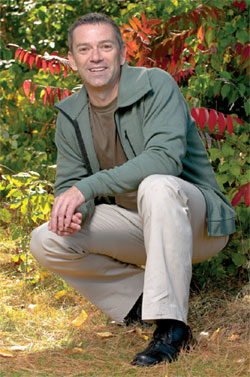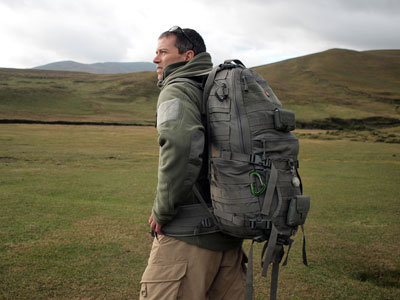 |
 |
| current issue |  | past issues |  | send a letter/news |  | address update |  | advertise |  | about us |  | alumni home |
Alumni Profiles
|
Wild Things Daniel Hilliard '88 helps endangered species survive By Kurt Mullen '94 |
Easy to print version |
 Lisa Nugent/UNH Photographic Services |
The Andean condor hops tentatively onto the scrubby Patagonian plateau, leaving its plastic crate behind. Condors are the largest flying bird in the world, with wings that can span 10 feet. This young condor jumps into the air and easily soars over the Atlantic Ocean.
Daniel Hilliard '88 has helped to make this day happen, and now he watches this flight alongside his allies in condor conservation. There's the team of scientists who have been working for years to prevent the condor from becoming extinct here in Argentina. And there are the members of the indigenous Mapuche tribe, who believe the condor is a sacred animal that will deliver their hopes and prayers to the heavens. Later they celebrate together at a house party in the tiny village of Sierra Paileman, population 100, where a goat has been roasted for the occasion.
For 15 years, Hilliard has run the Zoo Conservation Outreach Group, a small nonprofit that supports long-term wildlife conservation projects in Latin America and the Caribbean. He's also the group's sole employee, which means he raises funds and gives out career development scholarships to zoo and aquarium professionals from his base in Silver Spring, Md., and then visits researchers when he can around the world.
Recently, he was in the Atacama Desert in northern Chile. The desert contains long stretches where rainfall has never been recorded and where virtually no vegetation exists. Temperatures can reach 122 degrees by day and drop to 40 below at night. Yet in these harsh conditions, flamingoes live in flocks often numbering in the thousands. Their population has been declining for 25 years, possibly due to local mining operations. In response, Hilliard's group has been supporting researchers who are tagging flamingoes to learn about their migration and nesting habits and determine key places for their protection.
 |
The plan worked. It took six months for the ad to pay for itself, but once it had, Rothman knew he had a realistic, reliable strategy for growth that precluded the need for outside financing. They placed a second ad and reinvested profits in a third. Then they targeted in-flight magazines, which attracted international customers.
By visiting a site like this, Hilliard can report on a project's progress to donors. And he often comes home with new perspective on his own work. "You're better able to appreciate the work and how committed the [field researchers] are," says Hilliard, who majored in political science and international affairs at UNH, earned a doctorate in Latin American studies at Tulane and was recently awarded the UNH International Affairs Alumni Award for International Education and Research. "It revitalizes me to get them the resources they need," he adds.
 |
Hilliard's work has taken him places that few people ever get to see. But it's not always a pleasure trip. In Bolivia, he had a close encounter with condor vomit; in an enclosure in Argentina, he was chased by a water snake; and in Costa Rica, he was given the task of measuring the testicles of Baird's tapirs. "That was my research contribution," he says, laughing.
In Sierra Paileman, a total of 30 condors have been released as part of the Andean Condor Conservation Project. Six have died from eating lead shot in animal carcasses or poisoned bait intended for animals that prey on livestock. Two, however, recently mated and produced two chicks in the wild. It was a first for the Andean Condor Conservation Project, and no doubt a cause for a major celebration.
Easy to print version blog comments powered by Disqus
